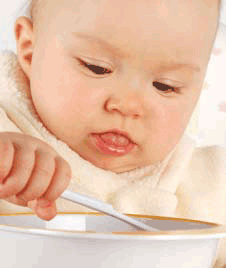-
Complementary food is needed when breast milk is no longer sufficient for baby’s nutritional needs.
True/False
-
It is best to start complementary feeding as early as possible so baby can get used to it at an earlier age.
True/False
-
The best first foods for babies are those that are smooth in texture such as rice porridge and ready-to-eat infant cereals.
True/False
-
If baby refuses to try or does not eat complementary food when first offered, this shows that baby is a picky eater.
True/False
-
Baby’s food may sometimes be too bland. You may add salt for taste.
True/False
Answers:
- True. Supplementing your child’s exclusive breastfeeding diet with complementary food is essential when he or she is 6 months of age or older. As your child gets older and bigger, he becomes more active. Additionally, this is also a stage where rapid development occurs. Thus, by this age, breast milk alone is not sufficient to fulfill his or her nutritional needs. Complementary food helps to fill the gap between the total nutrition needed by your child and the nutrients provided by breast milk, ensuring that your child will be able to sustain his growth. Remember to continue breastfeeding your child for up to 2 years of age, even after introducing complementary food.
- False. Starting your child on complementary food early is not a good thing. Firstly, your child may not be physically ready to accept solid or semi-solid food, which increases their chances of choking. Additionally, the complementary food may displace breast milk, leading to insufficient energy and nutrient intake in your child. Lastly, your child runs the risk of developing diarrhoeal diseases and other illnesses as their digestive system may not be fully matured. The World Health Organisation (WHO) recommends complementary feeding to begin when your baby is 6 months old.
- True. At the early stages of feeding, it is best to feed your child food that is smooth in texture. For example, pureed or strained food. Rice porridge and ready-to-eat-infant-cereals are perfect examples of food that is suitable for a child starting out on complementary food. On the other hand, solid food like chunky fruits will choke him as his oral-motor skills are not fully matured. Gradually change the texture of your child’s food as he grows older.
- False. Your child is not a picky eater. He may just be having a hard time adjusting to the new texture or taste as he is used to consuming breast milk. Start small by giving him 1-2 teaspoons twice a day. If your child refuses them, do not give up. Try giving him again later and he will eventually accept the new food. As time goes by, gradually increase the amount of food and the variety of food you offer your child. Most importantly, make eating time enjoyable and you will find your child enjoying his food.
- False. As much as you want your baby to eat “nice-tasting” food, it is best that you do not add salt to his food. Your child’s kidneys are not fully matured and will not be able to process excess salt from their food. In the long run, this can harm his or her kidneys. Children above the age of 1 year may eat food that are lightly seasoned with salt, but at the same time, try not to include too much salt in your child’s diet, whatever their age.






Comments